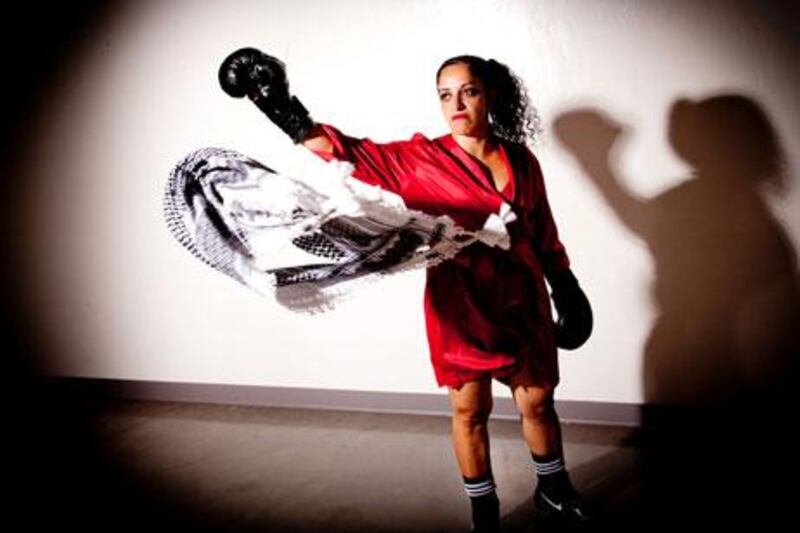Sama Alshaibi's latest exhibition explores masculinity and how men deal with oppression, writes Christopher Lord
Typing "fun" and "Saudi" into YouTube reveals a glut of home videos showing amateur car stunts on the streets outside Riyadh.
A personal favourite begins with an SUV hurtling down a sandy mototorway. As the car hits top speed, the daredevil inside jerks the handbrake, causing the vehicle to lift on its side and continue down the road on two wheels. Meanwhile, his accomplices clamber out on to the upended chassis, unscrewing both tyres that spin helplessly in the air.
All these automobile acrobats are men. Not only that, they have kindred spirits all over the region, as the internet abounds with such material. The Palestinian-Iraqi artist Sama Alshaibi wants to know why.
Her latest exhibition, vs Him at the Lawrie Shabibi gallery in Dubai, shows the artist in a typically visceral mode. She uses photography, video and - for the first time - sculpture to explore how masculinity is made manifest.
The Brother series is certainly among the stronger sections of this sizeable solo show. Alshaibi has filmed a friend in Palestine spinning doughnuts in his car. At one point the driver steps out, allowing his car to complete a full turn unmanned before he jumps back behind the wheel. Alongside this impressive video piece, she contrasts the flurry of disturbed shale and spinning rubber tyres with the flowing movements of an airborne dancer.
In another, Alshaibi has dressed up like a boxer, standing in a spotlight reminiscent of a Hollywood dream sequence. Filmed in stop-motion, she fistfights with "The Empire" - a figure garbed head to toe in tight black Lycra. It is, perhaps, an everyman adversary: an intangible opponent that frustrated individuals can fight and overcome in their dreams.
The central concern of Alshaibi's considered and conceptually diverse exhibition is about how men apprehend freedom, and a male identity, when prospects are low. Until the recent upheavals that have swept the Middle East, the "ceiling" of potential for men has been oppressively close, she says. "With limitation comes the notion of 'what's the point? Let's sit in the street, smoking shisha and complain'." Alshaibi regards innovation and change as essential components to a masculine identity. "Young boys are always testing the edge, always looking to climb the next wall." When that is stifled, she explains, masculinity finds an outlet in risky, destructive and nihilistic ways.
She talks about Egypt, especially during the Mubarak era, where she says friends regularly report sexual harassment.
The artist has also spent the past five years going back and forth between the US and Palestine. Observing the frustration in the West Bank has given her insight into the apathy among men she feels prevalent there.
"You watch a 35-year-old man having to give his paperwork to an 18-year-old with a gun," she says. "What does that do to a male psyche? It's such a closed community in Palestine, literally walled off from the world, so social conformity is a thousand-fold. At the same time, the occupation means that a man is constantly tested to protect his wife and family. This level of pressure pushes men into creating double lives for themselves."
The series of photographs vs The Lover explores exactly that. Alshaibi creates the timeline of a relationship across five images: The wooing suitor undergoes a lie detector test from his partner first, next they're garbed up for marriage. Before long, toys litter the floor and, in an image tellingly labelled The Betrayer, the husband is rubbing his head guiltily between peeks under the table at his phone.
The linearity that these images suggest has disturbed some of Alshaibi's viewers, particularly the final image of resignation, in which the couple are cuffed together as he blows shisha smoke into his nail-polishing wife's face.
Why, the artist asks, has she seen this evolution in relationships so many times? Something - often a need for catharsis - seems to push people to the side of their own lives. Oppression and stifling, she believes, trickles down into the home.
Alshaibi says that vs Him was conceived at the start of the Arab Spring. So what happens now that Egypt has punched right through the ceiling? "The imagination has been sparked," the artist explains. "I was there recently, and saw a very visual shift. It was evident just among my group of friends - people were setting stuff up, getting schemes moving; everybody's all about organising something these days."
Alshaibi leans back into her own sculpture - two wooden electric chairs that face each other, with straps on the arms and an electrode-like band to sink your head into. In one chair, a booming male voice emits from the headband, relaying monologues given by dictators during the recent uprising. In the other, Alshaibi herself reads out optimistic statements from her friends' Twitter feeds from that time. "This is a show about how we manifest freedom to cope with the everyday."
vs Him continues at Lawrie Shabibi in Al Serkal Avenue, Dubai, until October 20.





